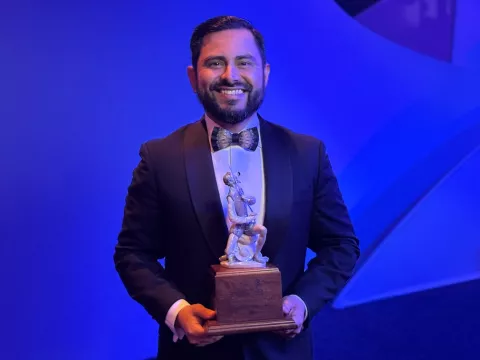- Megan Paquin
Choose the health content that’s right for you, and get it delivered right in your inbox.
When Chuck Schram had his first stroke in 2006, he had no idea his road to recovery would be so daunting. The long-term loss of mobility and strength on his left side made routine tasks impossible and, like most stroke survivors, his rehabilitation therapy eventually plateaued – leaving Chuck and his family wondering whether his limited hand and arm function would ever improve.
But today, there is renewed hope for Chuck and other ischemic-stroke survivors. Recently, AdventHealth became the first health care system in the Southeast to expand long-term stroke recovery care with six successful implantations of a new FDA-approved device shown to improve the effectiveness of rehabilitation therapy and significantly enhance patients’ hand and arm function.
Chuck was one of the first Orlando Neurosurgery patients to receive treatment with the Vivistim® Paired VNS™ System at AdventHealth. The device, which is implanted under the skin in the upper left chest area, connects through a stimulation lead to the vagus nerve. Combined with rehabilitation therapy aimed at increasing mobility and control of the upper extremities, this innovative medical technology can offer patients the chance to improve their recovery even after significant time has passed.
“Before now, effective treatments for long-term stroke recovery were limited,” said Dr. Ravi H. Gandhi, medical director of the AdventHealth Neuroscience Institute and partner at Orlando Neurosurgery, who led the team in bringing this breakthrough device to stroke survivors in Florida. “By combining a well-established surgical procedure for vagus nerve stimulation (VNS) with intensive, goal-oriented rehabilitation, we are transforming stroke recovery with the potential for greater independence and better quality of life overall.”
Occupational or physical therapists use a wireless remote to activate the Vivistim device while the patient completes various functional skills that are important to them like folding clothes, opening containers and cutting food. Once patients have graduated from the intensive program, they are then able to continue their progress through a self-directed, home-based therapy program using a magnet to activate the Vivistim System daily.
“This innovation may give patients who have plateaued in their recovery a new chance to fundamentally change their quality of life for the better,” said Dr. Chandan Reddy, head of the Deep Brain Stimulation program at AdventHealth Celebration and a board-certified neurosurgeon. “We are pleased to offer this breakthrough device to our patients and to be on the cutting-edge of helping improve long-term stroke recovery outcomes.”
Since completing his initial six-week rehabilitation protocol, Chuck has seen significant improvement in his shoulder, forearm and elbow movement, including rotation and flexion that were inaccessible prior to his implantation and therapy with Vivistim.
“He has had tremendous results,” said Dr. Gandhi. “Chuck is one of our first Vivistim success stories, and we expect many more just like him.”
For full safety information, please see www.vivistim.com/safety.
Recent News
The Inspiring Wholeness podcast explains how to start an exercise routine, stay motivated and build endurance safely, to find your inner Ironman.
As the world rang in 2025, AdventHealth for Women welcomed the very first babies of the new year.
Dr. Joseph Lopez, chief of pediatric head and neck surgery at AdventHealth for Children, was honored with the prestigious Professional of the Year Award at the 27th Annual Don Quijote Awards.
Giving back to his hometown, Dr. Ryan Day brings advanced robotic surgery to local patients, offering life-saving care close to home.
The holiday season can increase heart attack risks due to overindulgence, stress, and ignored symptoms, but Dr. Hector Lozano advises moderation, staying active, managing stress, and sticking to...
Transplant is AdventHealth Transplant Institute’s 5000th kidney transplant
Deputies from local fire and police departments dressed as elves and dropped in to visit patients as part of an eight-year long tradition bringing festive cheer to kids and families staying at the...
AdventHealth is now using a fluorescent dye that lights up cancer cells during surgery, which is providing faster, more accurate treatment for patients.
On the newest Inspiring Wholeness podcast, Obie Diaz, local morning radio show host, shares how a routine physical eventually led to two open heart surgeries.
Inspired to change statistics around Black maternal deaths, AdventHealth for Women's Fourth Trimester Program offers enhanced postpartum care for Black mothers with high blood pressure.
AdventHealth University and Jobs Partnership Build Health Care Workforce Pipeline from Underserved Communities.
New LifeWorks Program provides health care workforce training to under-skilled job seekers throughout Central Florida.












